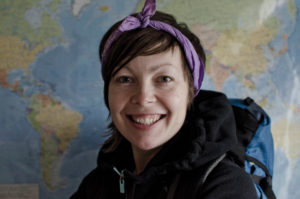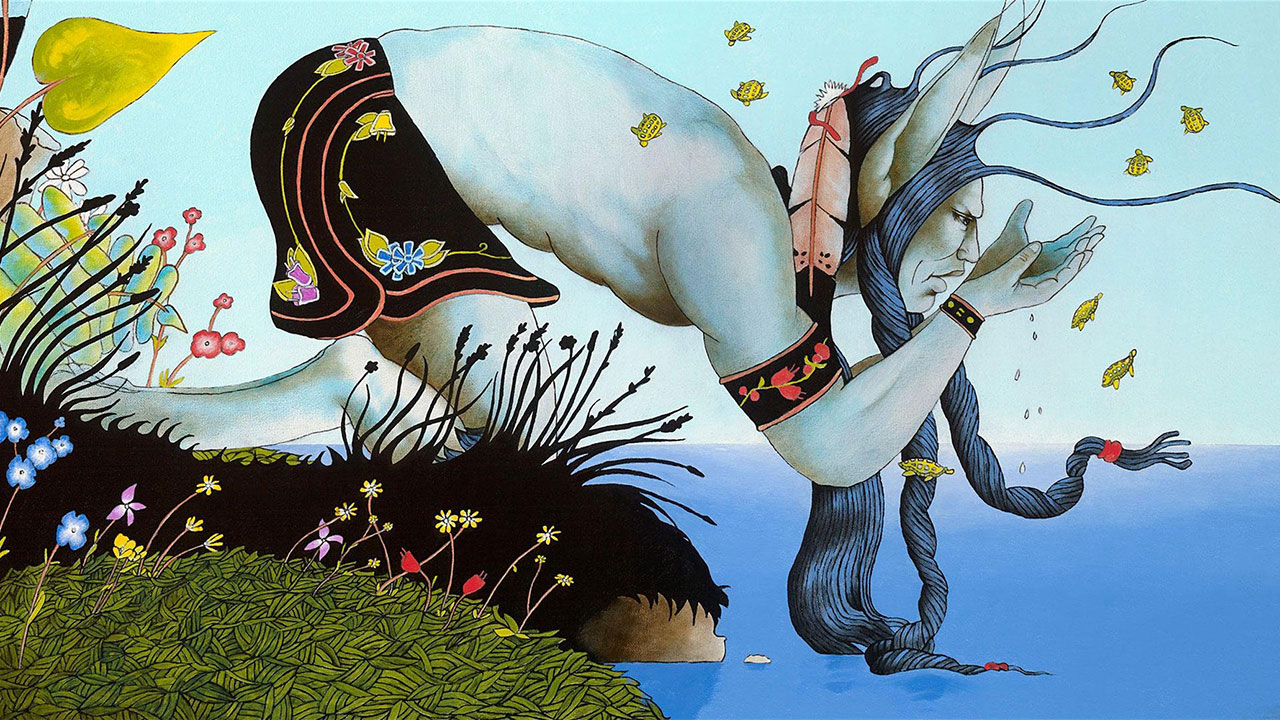Q&A: Lina Soblytė, Rabbett Before Horses
February 28, 2020 Leave a Comment
Ojibwe artist Rabbett Before Horses Strickland first shared his extraordinary work with PBS Wisconsin viewers in the documentary Ma’iingan: Brother Wolf. The vivid dreams depicted in his paintings reflect both timeless origin stories and the new world to come, drawing on “a thousand years of story.”
The new documentary Rabbett Before Horses, premiering 7 p.m. Tuesday, March 3, highlights the work of this talented Wisconsin artist, musician and theoretical mathematician, whose work reflects the culture of his community.
Over several years and many video shoots at his Red Cliff studio, videographer Lina Soblytė has developed a special relationship with this truly unique artist. Read on for some of her reflections!
How did you first get to know Rabbett?
Mik Derks, the producer, and Jon Miskowski, PBS Wisconsin’s director of television, had made the initial contact with Rabbett back in 2017. That was followed by another visit with a videographer and audio recordist before I got involved. I first met Rabbett during the shoot of our documentary Ma’iingan: Brother Wolf, in the fall of 2017.
On a personal level, I was already excited about the shoot before we started. Working in nature is where I am the happiest! Also, as an art lover, I was very intrigued. I felt a lot of respect and admiration towards Rabbett’s talent right away.
Over time, we’ve discovered more and more “Rabbett magic.” We found out about his music and his mathematical theories. And, of course, every time we visited, we saw new paintings. His walls were always covered.

Lina Soblytė, Videographer for ‘Rabbett Before Horses’
Why do you think Rabbett and his art deserve this spotlight?
His work is mind-blowing and mind-opening. I am totally biased because I’ve met the person behind it, but I know viewers will agree.
This film includes a lot of patient, closeup filming. How did you build a rapport?
Fairly quickly, Rabbett seemed to get used to my camera being right in his face or following his brush. At the very beginning of the first shoot, he poked himself with a sharp pencil and started bleeding from his finger. Fortunately, I had a bandage with me, so I got a gold star of trust right there.
Soon, I was asking him to do all sorts of things for the camera in order to get a feel for his environment. He found it quite entertaining; although he sometimes took a bit of convincing, there was no resistance. He kept giggling and talking to himself during some of those “pretend to be walking by yourself” moments, which meant that we couldn’t use the footage. It is definitely a big part of the “Rabbett magic.”
During one of our final visits, Mik was sorting through some photographs in another room while Rabbett and I discussed his music-making. It felt like two friends jamming together: Rabbett on keyboard, me with my camera, singing along. That was my favorite moment: the culmination of acceptance.
What are some of your own reflections about his art?
I am Lithuanian, and lived in Europe before coming to Wisconsin, so I had never met a Native American artist or been “up north.”
I have explored many galleries, but I’ve never seen anything like this before. Rabbett’s style is so unique: such a beautiful mix of classical and contemporary. The stories behind each piece make you appreciate it even more. You can stare at his paintings for a long time and keep finding something new.
Has Rabbett seen either of these films?
Last time I checked, no. I’d love to hear his opinion, but I don’t think he’s keen on watching himself. That’s my guess from what I’ve learned about him: he’s too busy for that.
I’ve told Mik that we should visit Rabbett and project the documentary on a wall. That might be the only way to get him to watch. I’d love to see his reactions. He’d probably giggle a lot.
What do you hope viewers will get out of this documentary?
I’ve only watched a couple parts of the final edit. I can’t wait to see the whole documentary, and relive these beautiful moments spent with this amazing, incredibly talented person.
I hope viewers will find a connection with Rabbett no matter how different they think they are. In fact, I’m sure everyone will, whether they’re interested in art, music, math, Native American culture, nature… The documentary covers so many subjects.
Above all, it shows a kind human. I hope that Rabbett will inspire others to do more of what they love, to respect art more, to find more joy in little things.
Art Native American Ojibwe Ma'iingan: Brother Wolf First Nations
 Passport
Passport






Follow Us